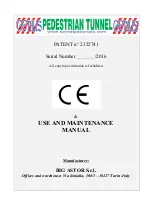
Operation
26
04.00 | FDB | Assembly and Operating Manual | en | 389072
operational robot path speed, the burr is deflected but contacts
the work surface. Once the robot path has been confirmed, the
compliance force of the burr should be adjusted
order to achieve a correct depth of cut.
6.6 Cutter Operation and Burr Selection
The FDB will perform best in “climb milling”. This refers to a cutter
whose directions of traverse and cutter rotation are the same. In
the case of the FDB, the cutter rotation is clockwise when viewed
from above. Climb milling would therefore involve clockwise
motion around the outside of a part being deburred. In climb
milling, the heaviest cut is made as the tool enters the workpiece
and the chip becomes narrower as the cut is completed. In
“conventional milling”, the cutter travels in a direction opposite of
cutter rotation. This may aid in cutter stability for some
operations, however, the cutting edge of the tool is subjected to
higher friction and cutting forces. Tool wear is accelerated in this
mode and surface finish quality will generally be reduced. When
“conventional milling”, extra care must be taken around corners.
This poses a potential hazard where the cutting force can deflect
the burr causing the burr to break as the machine/robot continues
along its path.
The selection of a cutting tool is highly dependent upon the part
material and geometry, and the depth of cut. It is not practical to
present all the possibilities in this document. Please
see
of this document for a short list of burrs and
suitable applications. It is worth mentioning here that a specific
family of burrs is available for working with die cast alloys,
aluminum, and plastics. These cutters have fewer teeth and
increased relief to minimize chip loading.
Plastics represent the most difficult deburring challenge due to the
phenomenon of chip re-welding. In this process, if the cutter is dull
or the feeds and speeds are not correct for the material removed,
chip will melt and weld to the cutter or the work piece. This can
quickly load a cutter and produce unacceptable results. In general,
the traverse or feed rate of the FDB will be higher for plastics to
minimize this behavior. This results in larger cuts, which more
effectively remove heat from the cutter-tool interface.
6.6.1 Burr Selection Table
Standard length commercial burrs are used with FDB products. The
length of these tools is typically around 2 inches for 1/4” shank
diameter burrs [50mm for 6mm diameter]. Longer shank burrs are
available from industrial suppliers and will appear in their catalogs
with descriptions such as “long” or “extended” shank. Their use is
to be avoided. Using extended or long shank burrs in the FDB will
















































